We often need to find the derivative of a square root in calculus courses. We can calculate the derivative of a square root using the limit definition or by using a shortcut, described below.
So, how do you take the derivative of a square root? To take the derivative of the square root function f(x) = √x, first convert to the form f(x) = x1/2. Next, use the power rule for derivatives to find f’(x) = (1/2)*x-1/2. Then, simplify to the form 1/2√x. We can also use the chain rule to find the derivative of a square root composition function.
Of course, a similar rule applies for taking the derivative of cube root, fourth root, and other radical functions.
In this article, we’ll talk about how to take the derivative of a square root function and when to use the chain rule. We’ll also look at several examples to make the concepts clear.
Let’s get started.
Derivative Of A Square Root
The derivative of a square root function f(x) = √x is given by:
- f’(x) = 1/2√x
We can prove this formula by converting the radical form of a square root to an expression with a rational exponent. Remember that for f(x) = √x. we have a radical with an index of 2.

This gives us a rational exponent of 1/2. So, we have:
- f(x) = x1/2 [this is equivalent to f(x) = √x]
Remember that the power rule for derivatives tells us that for g(x) = xN, the derivative is given by:
- g’(x) = NxN-1
Using the power rule (with N = ½] to take the derivative of f(x) gives us:
- f’(x) = (1/2)*x(1/2) – 1 [here, N = 1/2]
- f’(x) = (1/2)*x-1/2
- f’(x) = 1/2x1/2 [since x-1/2 = 1/x1/2]
- f’(x) = 1/2√x
Here is the graph of f’(x) = 1/2√x, the derivative of f(x) = √x:

By similar reasoning, we could find the derivative of cube roots, fourth roots, and so forth:
| Function | Derivative |
|---|---|
| Cube Root f(x) = x1/3 | f’(x) = 1/(3x2/3) |
| Fourth Root f(x) = x1/4 | f’(x) = 1/(4x3/4) |
| Fifth Root f(x) = x1/5 | f’(x) = 1/(5x4/5) |
| Nth Root f(x) = x1/N | f’(x) = 1/(Nx(N-1)/N) |
functions and their derivatives.
Derivative Of A Square Root With The Chain Rule
To find the derivative of a square root with function composition, we will need to use the chain rule.
Remember that the chain rule tells us: for the function composition f(g(x)), the derivative is f’(g(x))*g’(x):
- If h(x) = f(g(x)), then h’(x) = f’(g(x))*g’(x)
This assumes that the functions are differentiable.
Applying the chain rule when f(x) is a square root function would give us:
- If h(x) = √g(x), then h’(x) = (1/2)*g(x)-1/2*g’(x)
After simplifying, we get h’(x) = g’(x)/2√g(x)
How To Find The Derivative of A Square Root Using The Definition
We can also use the limit definition to find the derivative of a square root.
Remember that the limit definition of a derivative tells us that:
- f’(x) = limh–>0 [f(x + h) – f(x)] / h
Using f(x) = √x in the equation above, we get:
- f’(x) = limh–>0 [√(x + h) – √x] / h
We will multiply the top and bottom by √(x + h) + √x, which is the conjugate of the numerator.
The new numerator is:
- [√(x + h) – √x]*[ √(x + h) + √x] = (x + h) – x [the middle terms cancel when we use FOIL]
Since (x + h) – x = h, then our new numerator is h.
The new denominator is h*[√(x + h) + √x].
So, the new limit is:
- f’(x) = limh–>0 [h] / h*[√(x + h) + √x]
- f’(x) = limh–>0 [1] / 1*[√(x + h) + √x] [cancel the h in the top and bottom]
- f’(x) = [1] / 1*[√(x + 0) + √x] [substitute h = 0]
- f’(x) = [1] / 1*[√(x) + √x]
- f’(x) = [1] / [2√(x)] [combine like terms in the bottom]
- f’(x) = 1/2√x
This is the same as (1/2)*x-1/2, which is what we get from the power rule for derivatives.
How To Take The Derivative Of A Square Root
To take the derivative of a square root, your best bet is to start by converting from a radical to an expression with a rational exponent. Then, you can use the power rule for derivatives (and if necessary, the chain rule) to find the derivative.
Let’s look at some examples.
Example 1: What Is The Derivative Of Square Root Of 2x?
Let’s say we want to take the derivative of the function f(x) = √(2x). Its graph is shown below.
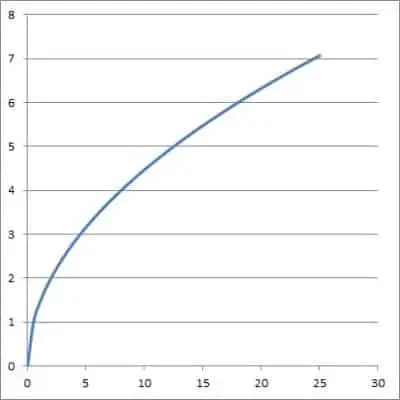
First, we convert the radical to an expression with a rational exponent:
- f(x) = √(2x)
- f(x) = (2x)1/2
Now, we use the power rule and the chain rule to take the derivative:
- f’(x) = (1/2)(2x)-1/2*(2) [the ½ is from the power rule, and the 2 is from the chain rule]
- f’(x) = (2x)-1/2 [(1/2)*2 = 1]
- f’(x) = 1/(2x)1/2
- f’(x) = 1/√(2x)
You can see the graph of f’(x) = 1/√(2x) below.
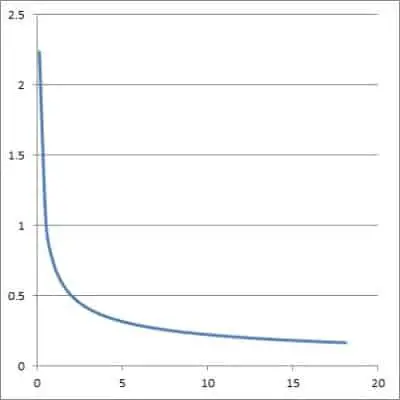
Example 2: What Is The Derivative Of Square Root Of 3x?
Let’s say we want to take the derivative of the function f(x) = √(3x). Its graph is shown below.
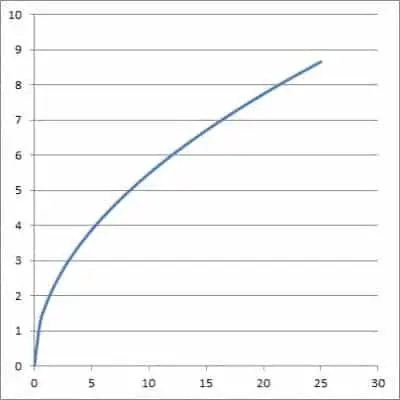
First, we convert the radical to an expression with a rational exponent:
- f(x) = √(3x)
- f(x) = (3x)1/2
Now, we use the power rule and the chain rule to take the derivative:
- f’(x) = (1/2)(3x)-1/2*(3) [the ½ is from the power rule, and the 3 is from the chain rule]
- f’(x) = (3/2)(3x)-1/2 [(1/2)*3 = 3/2]
- f’(x) = 1.5/(3x)1/2
- f’(x) = 1.5/√(3x)
You can see the graph of f’(x) = 1.5/√(3x) below.
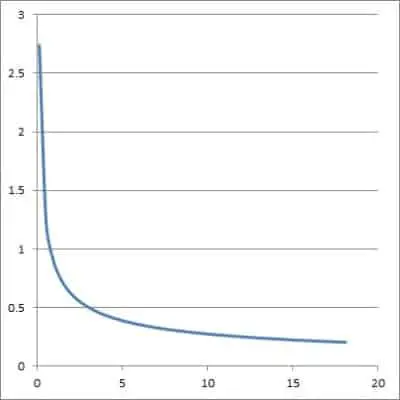
Example 3: What Is The Derivative Of Square Root Of x + 1?
Let’s say we want to take the derivative of the function f(x) = √(x+1). Its graph is shown below.
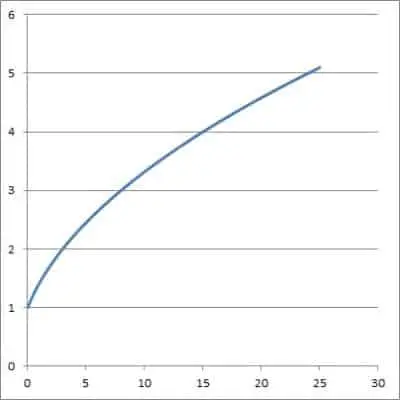
First, we convert the radical to an expression with a rational exponent:
- f(x) = √(x+1)
- f(x) = (x+1)1/2
Now, we use the power rule and the chain rule to take the derivative:
- f’(x) = (1/2)(x+1)-1/2*(1) [the ½ is from the power rule, and the 1 is from the chain rule]
- f’(x) = 0.5*(x+1)-1/2
- f’(x) = 0.5/(x+1)1/2
- f’(x) = 0.5/√(x+1)
You can see the graph of f’(x) = 0.5/√(x+1) below.
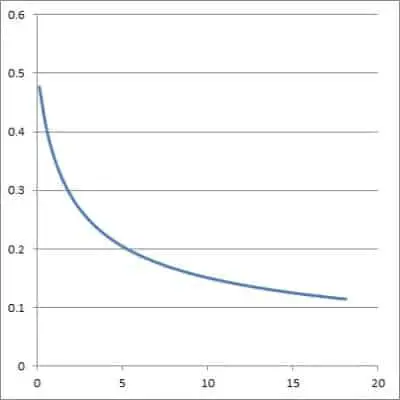
Example 4: What Is The Derivative Of Square Root Of 1 – x2?
Let’s say we want to take the derivative of the function f(x) = √(1 – x2). Its graph is shown below.

First, we convert the radical to an expression with a rational exponent:
- f(x) = √(1 – x2)
- f(x) = (1 – x2)1/2
Now, we use the power rule and the chain rule to take the derivative:
- f’(x) = (1/2)(1 – x2)-1/2*(-2x) [the ½ is from the power rule, and the -2x is from the chain rule]
- f’(x) = -x*(1 – x2)-1/2 [(1/2)*(-2x) = -x]
- f’(x) = -x/(1 – x2)1/2
- f’(x) = -x/√(1 – x2)
You can see the graph of f’(x) = -x/√(1 – x2) below.

Example 5: What Is The Derivative Of Square Root Of x3?
Let’s say we want to take the derivative of the function f(x) = √(x3). Its graph is shown below.
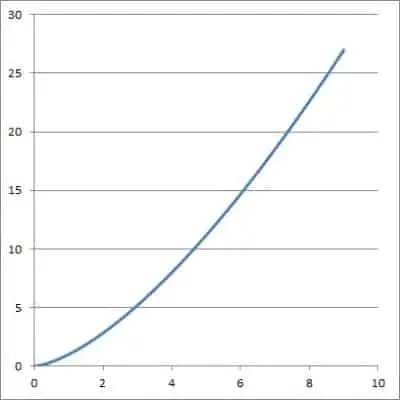
First, we convert the radical to an expression with a rational exponent:
- f(x) = √(x3)
- f(x) = (x3)1/2
- f(x) = x3*1/2
- f(x) = x3/2
Now, we use the power rule to take the derivative:
- f’(x) = (3/2)x1/2
- f’(x) = 1.5√x
You can see the graph of f’(x) = 1.5√x below.
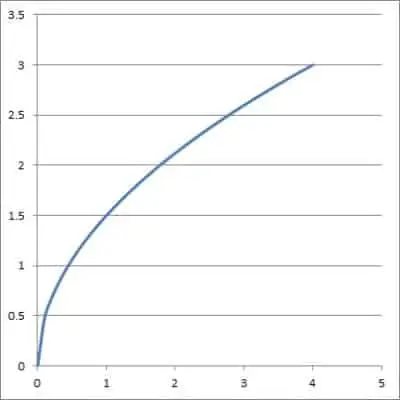
Example 6: What Is The Derivative Of Square Root Of 1/Square Root Of x?
Let’s say we want to take the derivative of the function f(x) = √(1/√x). Its graph is shown below.
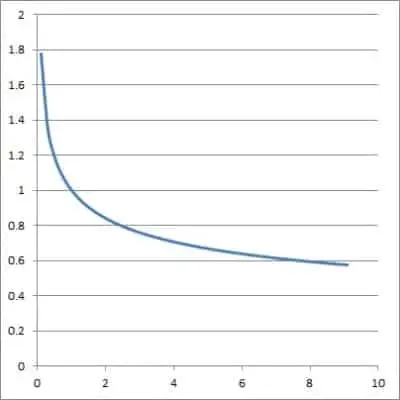
First, we convert the radical to an expression with a rational exponent:
- f(x) = √(1/√x)
- f(x) = √(1/x1/2) [√x = x1/2]
- f(x) = √(x-1/2) [1/x1/2 = x-1/2]
- f(x) = (x-1/2)1/2
- f(x) = x(-1/2)*(1/2)
- f(x) = x-1/4
Now, we use the power rule to take the derivative:
- f’(x) = (-1/4)x-5/4
- f’(x) = -0.25/x5/4
You can see the graph of f’(x) = -0.25/x5/4 below.
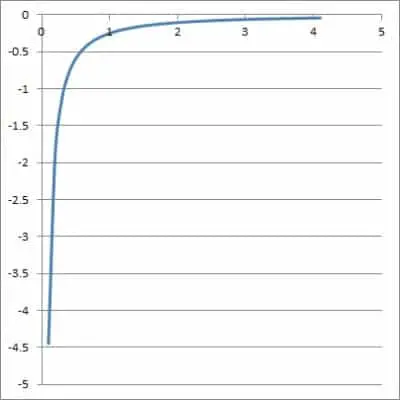
How To Find The Second Derivative Of A Square Root
To find the second derivative of a square root, we use the power rule to take the derivative of the first derivative.
If f(x) = √x, then f’(x) = (1/2)x-1/2, as we saw earlier.
If we take the derivative again, we get:
- f’’(x) = (-1/2)*(1/2)*x-1/2 – 1
- f’’(x) = (-1/4)*x-3/2
- f’’(x) = -1/4x3/2
This second derivative tells us the concavity of the square root function f(x) = √x. Since f’’(x) < 0 (it is always negative), we know that the graph of f(x) = √x is concave down (concave).
Conclusion
Now you know how to find the derivative of the square root function. You also know how to find derivatives for some of its common variations by using the chain rule.
You can learn how to graph a function from its derivative here.
I hope you found this article helpful. If so, please share it with someone who can use the information.
Don’t forget to subscribe to my YouTube channel & get updates on new math videos!
~Jonathon

